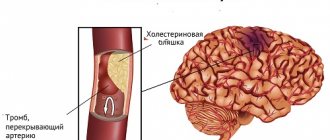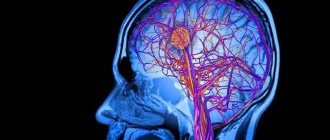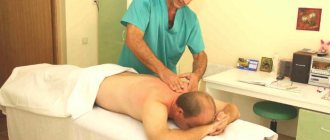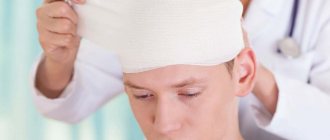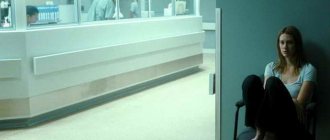In modern society, the incidence of strokes is increasing. Only 15-20% of patients can return to normal social activities after an attack. In 75% of cases, stroke of the ischemic type develops. Therefore, prevention of the disease and urgent treatment at a medical facility at the first symptoms of an attack are so important. This article will discuss left-sided ischemic stroke, its symptoms, diagnostic methods and treatment.
What functions is the left hemisphere of the brain responsible for?
The left hemisphere is responsible for:
Abstract logical thinking.
- Analysis of information received from outside.
- Ability to learn languages.
- Mathematical abilities (number operations).
- Information processing.
- Cause-and-effect relationships.
- Ability to read and write.
- Remembering important information (dates, names).
- Understanding the literal meaning of words.
- Muscle movements in the opposite half of the body (right).
For what reasons can a left-sided stroke occur?
The causes of a stroke in the left hemisphere of the brain can be:
Atherosclerosis of cerebral arteries. The disease develops over years and can progress. It is based on dyslipidemia (violation of the ratio of atherogenic and antiatherogenic lipoproteins). The concentration of LDL (low-density lipoprotein) increases in human blood. They are deposited on the endothelium of the vessel. Grease spots form. Then calcification (deposition of calcium salts) is observed. Hard plaques appear, reducing the lumen of blood vessels. This impedes blood flow.
- Smoking. Cigarette smoke contains a large amount of harmful substances that damage blood vessels (narrow them, reduce elasticity) and make the blood more viscous. The consequences may be thrombosis, atherosclerosis and arterial hypertension (high blood pressure). Cigarette smoke contains tar, formaldehyde, carbon monoxide, hydrogen cyanide, and nicotine. Passive smoking increases the likelihood of developing a cerebral infarction (ischemic stroke) by 20-25%.
- Arterial hypertension (pressure above 139/89 mm Hg). It can be primary (underlies the development of hypertension) and secondary. Risk factors include smoking, stress (promotes the release of adrenaline and norepinephrine), kidney disease (glomerulonephritis), thyrotoxicosis, hyperthyroidism, vascular abnormalities and pheochromocytoma.
- Regular hypertensive crises. They are characterized by episodes of sharp increases in blood pressure, the value of which exceeds the threshold. During a crisis, a narrowing of blood vessels is observed, against the background of which the pressure rises.
- Thrombosis of cerebral vessels. Blood clots form when the speed of blood flow decreases at the site of damage to the endothelium (the inner layer of blood vessels). The reasons for their appearance may be septic conditions, myocardial infarction, valve pathology, atrial fibrillation, blood thickening, prolonged immobilization, surgery, malignant tumors, autoimmune pathology, polycythemia, antiphospholipid syndrome, infections and lipid metabolism disorders.
- Thromboembolism. With this pathology, a detached blood clot or its fragment clogs the cerebral arteries. Risk factors are physical inactivity, high blood pressure, varicose veins, thrombophlebitis, deep vein thrombosis, increased thrombosis (thrombophilia), coronary heart disease and heart rhythm disturbances. Left-sided ischemic stroke occurs when the cerebral arteries are blocked by more than 70% or are completely obstructed.
- Diabetic macroangiopathy. One of the complications of diabetes mellitus, which is based on atherosclerotic changes. Characterized by damage to large arteries. Vessels lose their elasticity, become fragile and brittle. The consequence may be destruction of the walls of the arteries, the cause may be an increased concentration of glucose in the blood.
- Aneurysm of cerebral vessels. Local pathological protrusion of the inner layer of the artery is characterized by the fact that in this area the vessel becomes thin and less elastic. A sudden increase in blood flow can cause aneurysm rupture and hemorrhage.
- Myocardial infarction. An acute form of ischemic disease, in which a zone of necrosis forms in the heart muscle. A complication of a heart attack is thrombosis. Heart attacks develop in older women and men (over 50 years old). Predisposing factors are hypertension, stress, smoking, alcoholism, atherosclerosis and angina.
- Atrial fibrillation (atrial fibrillation). A prolonged attack provokes the development of thrombosis and ischemic stroke.
- Arteriovenous malformation. Congenital pathology, in which there is a pathological area without capillaries, and the arteries immediately turn into veins. A frequent complication is hemorrhage in the brain (under the membranes or in the parenchyma). The cause of malformation is a violation of intrauterine development.
- Obesity. Stroke is more often detected in obese people due to impaired fat metabolism.
- Taking drugs.
- Systemic pathology (lupus erythematosus, rheumatism).
- Vasculitis (inflammation of blood vessels).
Predisposing factors include:
alcoholism;
- poor nutrition (excess salt, abuse of fatty foods, addiction to sweets and baked goods);
- hereditary predisposition;
- low physical activity (sedentary or lying down lifestyle);
- cervical osteochondrosis;
- elderly age;
- uncontrolled use of drugs (anticoagulants, antiplatelet agents, antifibrinolytics, oral contraceptives);
- stress.
What it is?
An ischemic stroke, which affects the left side of the brain, is a fairly severe pathology, often leading to death. The reason for high mortality is most often the fact that it is not possible to make an accurate diagnosis in time at a time when the speed of providing assistance to the affected person is of great importance. In addition, even timely treatment does not guarantee that the patient will be able to avoid serious consequences.
An ischemic stroke, when the right side is “affected”, differs from the left side both in symptoms, and in the method of therapy, as well as in rehabilitation methods.
Paralysis of the left side is possible only if the right hemisphere of the brain is damaged.
Background and main types of symptoms
In ischemic form
The prerequisites for the occurrence of a stroke are:
- Recurrent headache. May be a sign of chronic cerebrovascular insufficiency and arterial hypertension.
- Memory deterioration, decreased attention and intelligence. They are signs of progressive atherosclerosis of the cerebral arteries.
- Constant increase in blood pressure. Manifested by headache, sweating, fog before the eyes, tinnitus, weakness, nausea, vomiting, dizziness, sleep disturbance.
- Cardiac symptoms (chest pain, shortness of breath at rest and during exercise, palpitations, a feeling of interruptions in the heart, tachycardia).
Precursors of acute cerebrovascular accident (ACVA) are headache, general weakness, psychomotor agitation, feeling of fear, weakness in the arms and legs.
For left-sided ischemic stroke the following are typical:
- Paralysis of the right side of the body. The process may involve 1, 2 or all 4 limbs.
- Paresis (decreased range of motion). Hemiparesis often occurs (damage to the muscles of the right arm and right leg).
- Changes in facial expressions on the right side of the body (lowering of the right corner of the mouth, distortion of the face, narrowing of the right eye).
- Impulsive, quick behavior.
- Deterioration of motor memory.
- Hearing loss.
- Impaired consciousness. Somnolence (the person is in a state of light sleep, but can be awakened), lethargy (stupor), stupor and coma are possible. In the latter case, the patient loses consciousness and does not respond to external stimuli.
- Eye disorders (visual hallucinations, pupil deviation to the left). Sometimes complete gaze paralysis occurs.
- Limb ataxia (motility disorder). Symptoms include excessive bending of the knees, unsteady gait, swaying, slowness, clumsiness, and wide movements. In severe cases, the ability to stand and walk is lost.
- Dysarthria. Occurs with a stroke in the basin of the left middle cerebral artery. It manifests itself as a violation of articulation (pronunciation of words). The reason is dysfunction of the vocal apparatus, including muscles. The most common signs are unclear and slurred speech, strong closing of the lips, tension of the tongue, facial and neck muscles, increased salivation, distortion of sounds, slow speech, insufficient voice strength, monotony, and change in timbre.
- Aphasia. Inability to use existing speech. Patients cannot describe pictures, read text clearly and understandably, or name an object. It also makes it difficult to understand someone else's speech. All this makes it impossible to communicate with loved ones.
- Dyslexia. The patient confuses words or letters.
- Apraxia. Impaired ability to perform actions consistently. Patients are unable to fasten buttons, put on clothes, tie shoelaces, make the bed, or use objects. Apraxia in stroke is most often bilateral, but the lesion is weaker on the left side.
- Agnosia. Difficulty recognizing tactile, sound and visual stimuli. Patients confuse objects, do not understand speech, and cannot count. A type of this pathology is anosognosia (ignoring one’s disease or individual symptoms).
- Dysgraphia or agraphia. Violation of writing. It is manifested by the replacement of letters with similar spellings (m-l, v-d), rearrangement of syllables and letters, long omissions, violation of spelling (separateness and unity of spelling of words) and coordination of words in sentences.
For hemorrhagic stroke
Symptoms of hemorrhagic stroke are:
Impaired consciousness, up to deep coma.
- Convulsions similar to an epileptic attack. Clonic and tonic convulsions are observed. They are uncontrolled strong contractions (twitching) of individual muscle groups.
- Dizziness.
- Impaired taste sensitivity.
- Difficulty swallowing (dysphagia).
- Focal symptoms. In acute hypoxia of the temporal lobe, deafness, auditory hallucinations, tinnitus, memory loss and complex hallucinations are observed. In case of damage to the occipital lobe of the left hemisphere of the brain, visual symptoms appear (vision loss, hemianopsia, visual hallucinations and illusions). Signs of hypoxia of the parietal lobe are impaired tactile sensitivity, postural disorders, difficulty reading, writing and counting, and agnosia. Symptoms of damage to the frontal lobe include paresis, unsteadiness of gait, anosmia, and pathological reflexes.
- Meningeal signs (Brudzinski, stiff neck, Kernig).
- Aphasia.
- Mental disorders (jocularity, foolishness, indifference, rage, apathy).
Clinical picture
Ischemic stroke of the left hemisphere manifests itself in the form of characteristic symptoms that reflect the clinical picture of the pathology. They are most pronounced during the pre-stroke state:
- prolonged migraines accompanied by sound and photophobia;
- chest pain;
- blood pressure surges;
- gagging;
- nausea;
- clouding of consciousness and stiffness of movements.
A stroke occurs within minutes. Acute circulatory disorders in the brain are accompanied by:
- convulsions;
- paresis of the upper and lower extremities;
- a lopsided smile (one corner of the mouth is downturned);
- incoherent speech or its complete absence;
- short-term amnesia;
- partial or complete paralysis of the left side of the body.
With an ischemic stroke, the patient is unable to raise his left arm up. Coordination of movements is impaired. With ischemia, sagging skin occurs on the left side of the face.
Danger of left-sided stroke
The most dangerous is a left-sided hemorrhagic stroke of the brain. Its mortality rate exceeds 50%. If you wait until the symptoms disappear and do not call an ambulance in a timely manner, your chances of survival are slim.
Survivors may experience severe complications and residual effects. Relapses occur frequently.
The importance of timely diagnosis
Patients should be treated after a preliminary diagnosis has been made. It is important to establish the type of stroke (hemorrhagic or ischemic). Treatment tactics and choice of medications depend on this. The diagnosis should be made within the first hours after the onset of symptoms. Late diagnosis worsens the prognosis for life and makes treatment ineffective.
If an acute cerebrovascular accident is suspected, the following is carried out:
Survey. Complaints, the time of their occurrence, and risk factors are determined.
- Physical examination. Includes percussion, palpation and auscultation.
- Measuring blood pressure, counting pulse and breathing rate.
- Visual inspection.
- Neurological examination (detection of pathological reflexes, assessment of sensitivity, determination of muscle tone and range of motion, examination of the fundus).
- Special tests for stroke.
- CT and MRI (computer and magnetic resonance imaging). The most informative research methods to identify areas of cerebral vascular damage. Signs of hemorrhage are swelling and the presence of a hematoma.
- Electromyography.
- Electroencephalography.
- ECG. It is carried out to assess cardiac function and exclude myocardial infarction.
- Ultrasound of the heart.
- Angiography (x-ray examination of the arteries of the brain).
- Duplex scanning.
- Rheoencephalography. Allows you to evaluate the filling of blood vessels and the speed of blood flow.
- Coagulogram.
- Clinical and biochemical tests.
- Lumbar puncture.
- Cerebrospinal fluid analysis.
Diagnostics
A left-sided stroke can be diagnosed fairly quickly, which can save a person’s life. A dysfunction of the left hemisphere can be detected by the following signs:
- Loss of consciousness, fainting state.
- Unnatural smile, skewed to one side.
- Impaired balance and movements.
- Drawing, illogical speech.
On this topic
- Stroke
6 reasons for stroke at a young age
- Natalia Sergeevna Pershina
- May 25, 2020
The patient may complain of headache, dizziness, double vision. The presence of even one or two symptoms is sufficient reason to call a medical team.
In the hospital, the doctor conducts a full diagnosis, which includes:
- Collecting a complete medical history, examination by a neurologist.
- Conducting laboratory diagnostics - blood sampling for general analysis, coagulogram.
- Complete examination of the body.
- Recording indicators .
- Examination on ECG machine.
- Performing an MRI or CT scan of the brain to study the location and extent of the lesion. If it is necessary to accurately identify the site of vessel occlusion, MR angiography is also performed.
The doctor must determine whether it is an ischemic stroke or another disease with similar symptoms. So, hemorrhage, infection of the meninges or tumor may form.
General consequences of the disease
The consequences of a stroke - right-sided and left-sided - can be:
paralysis and paresis;
- hearing and vision impairment;
- complete or partial memory loss;
- behavior change;
- thinking disorder;
- loss of reading, writing and counting skills;
- brain dislocation;
- cerebral edema;
- loss of control over pelvic organ functions (urination and bowel movements);
- coma;
- problems with eating;
- depression;
- contractures;
- thrombosis and thromboembolism;
- bedsores;
- acute respiratory failure;
- aspiration or congestive pneumonia;
- sensitivity disorders;
- death;
- hydrocephalus;
- breakthrough of blood into the cavity of the ventricles of the brain;
- post-stroke epilepsy;
- impaired coordination of movements;
- muscle spasticity.
Consequences and complications
The human brain is the most important organ, and if it malfunctions, all body systems are affected. When a stroke develops, the process affects not only the brain; those functions for which it is responsible are disrupted.
On this topic
- Stroke
What are the risks of a brain stem stroke?
- Natalia Sergeevna Pershina
- March 26, 2020
The consequences of damage to the left hemisphere can be different:
- noticeable speech in a person, its slow recovery, which is often incomplete;
- change in behavior, appearance of aggression, delayed reaction;
- problems with removing excess substances from the body;
- the appearance of mental disorders, laughing or crying “inappropriately”;
- retardation of movements;
- difficulty swallowing, difficulty eating;
- epilepsy.
The older the patient who has suffered a stroke, the worse his state of health, the greater the likelihood that many of the consequences of the disease will not be cured, and the person will remain disabled.
Complications may arise that greatly interfere with the patient’s recovery and rehabilitation. These include fever, convulsive reactions, pressure and severe pain in the head.
Often a situation arises in which the patient does not realize everything that has happened to him and does not want to participate in rehabilitation, believing that everything is fine with him. He does not notice disturbances of consciousness, tremors in the fingers, paralysis, and is completely indifferent to everything that happens. This can significantly complicate the recovery process.
Consequences of a stroke on the left side
Acquired epilepsy
Epileptic seizures are a complex of symptoms (mental, motor, sensory) associated with overexcitation of neurons and the occurrence of strong discharges. Symptoms include weakness, nausea, dizziness, chest pain, numbness in the lips, lump in the throat, tinnitus, loss of consciousness (with falling), pale skin, tilting of the head, clenching of the jaw, swelling of the jugular veins, foaming at the mouth, clonic convulsions, absence of tendon reflexes, dilated pupils.
Memory impairment
Senile stroke (after 80 years) is often accompanied by complete loss of memory (amnesia). Patients forget their relatives and their names. In milder cases, a person has difficulty remembering and reproducing the information received. He is unable to remember the phone number and the recipe.
Reading literature, logic games, simple memorization exercises, and listening to classical music help patients recover at home.
Problems with the speech apparatus
Speech disorders in the form of dysarthria, dysphonia and aphasia are the consequences of brain damage, neuronal death, disruption of communication between the brain and muscles, as well as damage to the vocal apparatus. Some patients stop speaking completely. Others pronounce words indistinctly, quietly, confuse words, rearrange syllables, replace letters. This makes it difficult to communicate verbally with loved ones.
Decreased vision
All types of stroke can cause decreased vision, blindness, and other eye symptoms (hemianopia, visual hallucinations, decreased visual fields). A left-sided stroke affects the right or both eyes. Complications of the disease can include increased intraocular pressure, blindness and cataracts (clouding of the lens). Patients often complain of blurred vision, blurry objects, veil or fog before the eyes, and flashes of light. Visual impairment is a consequence of damage to the occipital lobe of the brain.
Paralysis of the face, body and individual muscles
Facial paralysis in left-sided stroke occurs on the right side. Its typical signs are facial asymmetry, smoothness of the nasolabial fold, drooping of the corner of the mouth, involuntary closure of the eye, and narrowing of the right palpebral fissure. Patients cannot smile. This is the main diagnostic sign of stroke. The cause of facial asymmetry is a dysfunction of the facial muscles.
In more severe cases, paralysis of the right half of the body occurs. It is manifested by loss of sensitivity, numbness of the limbs, facial asymmetry, disturbance of the friendly movement of the eyeballs, changes in gait (up to the complete inability to stand and walk), drooping head, lack of muscle strength in the arms, nasality, slurred speech.
Mental disorder
The consequences of a stroke are the following mental disorders:
- depression (can cause suicide);
- aggressiveness;
- excessive activity;
- impulsiveness;
- hot temper.
Other consequences
Complications of acute stroke (acute cerebrovascular accident) also include social maladaptation, permanent disability, disability, impaired fine motor skills, and a person’s inability to self-care. Such people need help from loved ones and constant care.
Coma and death in severe cases
Coma is a dangerous condition characterized by impaired consciousness and manifested by a complete lack of communication between a person and the outside world. Symptoms of coma include depressed reflexes, lack of pupillary response to light, unconsciousness, slow heartbeat and high blood pressure. Many patients remain in a comatose state for several weeks or even months.
The mortality rate is determined by the type of stroke. With hemorrhage in the left hemisphere, the mortality rate exceeds 50%. With cerebral infarction, the prognosis is more favorable (mortality 15-20%).
Death may not occur immediately, but from complications (pneumonia, sepsis, cerebral edema).
Causes
Left-sided ischemic stroke is most often localized in the blood supply zone in the middle cerebral artery. These occur when arteries to the brain become narrowed or blocked, causing severely reduced blood flow (ischemia). The most common causes of left-sided ischemic strokes include:
- blood viscosity;
- rapid blood clotting;
- pathologies of the heart and blood vessels;
- overweight;
- violation of metabolic processes;
- diabetes;
- arrhythmia;
- slow blood circulation;
- heart failure;
- heart attack;
- embolism;
- heart valve pathologies;
- migraine.
Forecasts for the future
Life expectancy in different age categories
15-25% of patients die from cerebral infarction in the first month. This period is the most dangerous. In case of hemorrhage, this figure exceeds 40%. The 1-year survival rate for ischemic stroke reaches 60%, and for hemorrhagic stroke - 38%. The five-year survival rate is 31 and 24%, respectively.
The older the person, the worse the prognosis. In young people (under 40 years of age), life expectancy after a stroke can exceed 10-20 years.
In older people this figure is much lower. This is due to the presence of chronic diseases and weakening of the body.
Separately about patients with stroke
Patients with stroke are placed in the intensive care unit. The prognosis for life depends on many factors: the timeliness and correctness of treatment, the type of stroke, the person’s age, the quality of care, the presence of concomitant pathology, and a history of previous strokes or heart attacks.
What restrictions are possible?
During a stroke, patients should not eat or drink, move, speak or strain. Ensuring complete rest improves the prognosis.
Life forecast
The further condition of a person who has suffered a stroke largely depends on how quickly he was provided with specialized assistance in the required volume. If the attack occurs at home and the patient does not receive medical help, the probability of death is very high and is 95%.
The prognosis is individual for each person. The treatment and preventive measures taken, age and degree of brain damage are taken into account. More than 10% of people die in the first thirty days after a stroke. In the first year, survival rate is about 70%, and at the end of 5 years - 50%. Within ten years the figure drops to 25% survival.
The chances drop significantly if the patient suffers from hypertension, coronary heart disease, diabetes, or severe neurological deficits.
To increase the chances of a full recovery, you need to provide timely medical care, take all measures, begin rehabilitation and complete a full course of rehabilitation procedures. If the patient suffers from concomitant diseases, these also need to be treated.
On this topic
- Stroke
How to prevent spinal cord stroke
- Natalia Sergeevna Pershina
- March 26, 2020
Before reaching five years after the first stroke, a second one may occur. If this does not happen, then the chances of survival increase. Only about 11% of all patients experiencing ischemic stroke achieve a favorable outcome and complete recovery.
Only a quick diagnosis and timely treatment can save a person from disability or death. It is important to seek help when you notice the first signs of the disease.
First aid and further methods
First aid to the patient is provided by his family members or any other people nearby.
If a left-sided stroke is suspected, the following is required:
Feel the pulse and evaluate the reaction of the pupils.
- Calm the person down.
- Position the patient correctly. In case of vomiting and lack of consciousness, he is placed on his side and the leg is bent at the knee. If the person is conscious and is not vomiting, then he is placed on his back and a cushion of clothing or a pillow is placed under his head.
- Call an ambulance immediately.
- Stop using medications.
- Ensure airway patency (remove mucus and vomit, straighten a sunken tongue).
- Remove tight and constricting clothing.
- Warm the person if he is cold (in case of hemorrhage, thermal procedures are prohibited).
- Organize distracting procedures (foot baths). This is useful for high blood pressure.
- Refuse the person to drink water and eat food.
- If necessary, carry out resuscitation measures (artificial respiration, chest compressions). For 30 chest compressions, 2 breaths should be taken.
In the future (after the doctor arrives) you may need:
- use of medications;
- operation;
- connection to a ventilator;
- tracheal intubation.
Treatment
Before doctors arrive, primary care must be provided to the patient. While waiting for a medical team, you can improve your condition somewhat by doing a few things:
- Place the person on a surface covered with pillows, with the head raised.
- When you are in the house, open the window.
- Remove all constrictive clothing, unbutton your shirt and belt.
- If a person feels the urge to vomit, gently tilt his head to the side. This is done in order to prevent vomit from entering the throat and respiratory organs.
Doctors in a hospital setting provide basic and specific therapy, which helps minimize damage to nerve cells. Basic therapy is used to preserve the functioning of the brain and cardiovascular system. Specific measures are aimed at restoring blood circulation and brain tissue. The greatest effect is achieved with the combined use of methods.
If treatment does not produce results or is not effective enough, therapeutic and preventive measures and rehabilitation courses are carried out aimed at restoring body functions.
The doctor prescribes the patient to take medications from the following groups:
- Thrombolytics are used in the first hours after a stroke to resolve blood clots.
- Anticoagulants.
- Medicines to lower blood pressure.
- Vasoactive drugs.
- Neuroprotectors.
All medications are selected in accordance with the clinical picture of the stroke.
What is included in treatment and rehabilitation
The treatment regimen for stroke on the left includes the use of medications, urgent surgery (hematoma removal, decompression, thrombolysis, drainage), physiotherapy, exercise therapy, massage, oxygen therapy, complete rest, constant monitoring of vital signs (pulse, respiratory rate, pressure), refusal from bad habits, proper nutrition, treatment of existing pathologies (hypertension, atherosclerosis, heart rhythm disturbances).
Taking medications
For cerebral hemorrhage the following are used:
hemostatics (Vikasol);
- antihypertensive drugs (Captopril, Enalapril, beta-blockers);
- diuretics (Lasix, Torasemide, Diuver, Trigrim, Furosemide);
- sodium chloride solution;
- symptomatic drugs (antiemetics, analgesics, anticonvulsants);
- calcium channel blockers (Nimodipin-Nativ);
- antioxidants (Mildronat, Mexidol);
- ascorbic acid;
- calcium preparations;
- corticosteroids (Dexamethasone).
Treatment of ischemic stroke differs in that it uses statins (for atherosclerosis), antiplatelet agents and anticoagulants (Thrombo Ass, Aspirin, Clopidogrel, Warfarin), angioprotectors (Vazonit, Pentoxifylline, Trental), B vitamins, thrombolytics (Streptokinase, Thromboflux) and neuroprotectors ( Cavinton, Vinpocetine, Mexidol, Glycine, Lucetam, Nootropil, Piracetam, Cerebrolysin, Semax, Omaron).
Stroke Physiotherapy
For a stroke, the following can be done:
- magnetic therapy;
- exposure to vibration;
- acupuncture.
Exercise therapy and breathing exercises
Physical therapy is useful during the rehabilitation phase after the symptoms of the disease have subsided. It helps normalize muscle tone, improve blood flow, and reduce blood stagnation. Squeezing your arms, raising them in front of you, and raising and lowering your legs while lying down are helpful.
Breathing exercises are beneficial for the functioning of the heart and lungs. You can inflate balloons, hold your breath, or blow air through a straw.
Combating complications
If the left side is paralyzed after a stroke and there are complications, you may need:
- taking antibiotics (for pneumonia and sepsis);
- classes with a speech therapist (for speech disorders);
- massage;
- use of heart medications;
- wound healing, use of powders and creams, local antiseptics, dressing (for bedsores).
Lifestyle change
After a stroke it is recommended:
- relax more often in sanatoriums and resorts;
- move more;
- limit physical activity (do not lift heavy objects);
- eliminate stressful situations;
- listen to calm music;
- quit smoking and alcohol;
- walk in the fresh air more often;
- eat more fruits, berries and vegetables;
- limit the consumption of sweets, pickles, fatty foods and baked goods (for atherosclerosis);
- do not overeat;
- control your weight.
Rehabilitation therapy
Neurologists have developed a scheme for how to recover from an ischemic stroke in the left MCA or in another area of the brain. It includes:
- Massage. Rubbing and kneading the muscles improves blood supply and helps restore damaged innervation.
- Physiotherapy. A magnet, laser and other hardware procedures are used to improve tissue microcirculation and restore the conductivity of nerve fibers.
- Exercise therapy. An individually selected set of exercises helps restore motor function. With the help of exercise therapy, treatment after stroke, if the side of the body is paralyzed, is carried out by making the patient passive flexion and extension movements in the immobilized limbs.
- Diet. The diet of patients should consist of foods that are easily digestible. You should exclude fatty meats, smoked and pickled foods, baked goods, and also limit the consumption of salt and sugar. It is recommended to include vegetables, vegetarian soups and cereals in the menu.
- Classes with a speech therapist. Necessary for restoration of speech functions.
Neurologists are positive if folk remedies are used in addition to the main treatment. It is recommended to drink tincture of fir cones or decoctions of chamomile, St. John's wort, and sage. Traditional medicine recipes help improve the functioning of internal organs and prevent possible inflammation associated with weakened immunity.



